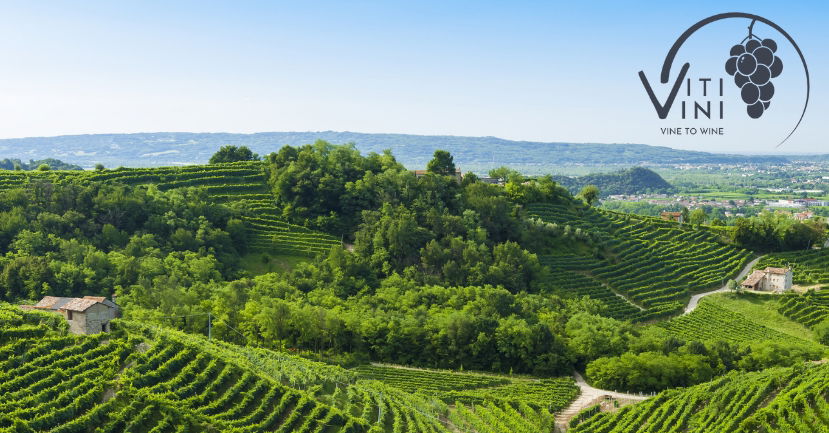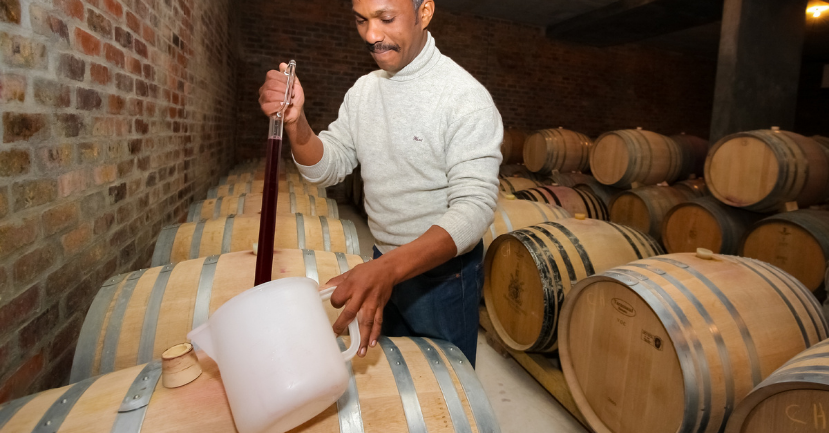BLOG
Vine to Wine: A Year of Viti/Vini - July
Nova Cadamatre MW
Wine Fundamentals

By July, the period of rapid shoot growth is over. The vine has now created all the leaves needed to ripen its fruit. In wet climates, shoot growth may continue but at a much slower pace. In dry climates, shoot growth stops completely. In very dry areas, the tendrils on the shoot can even dry out completely!
Lots of leaf pulling is done in July to open the fruit to sunlight and airflow. Airflow around the clusters helps cut down on diseases like botrytis. The sunlight that now can reach the fruit helps develop and increase the intensity of flavor compounds. This is particularly true in cool regions where the season is short and every ray of sunshine counts. Typically, there is still significant disease pressure, so managing the threat is very important, particularly in cool or humid climates.
Warm (and occasionally hot) weather is the norm for July in many growing regions. Because the vine’s metabolic processes are temperature sensitive, the vine is very reactive to changes in weather. On hot days, above 94°F/34.4°C, the vine closes its stomates (located on the undersides of the leaves). Stomates are tiny holes which take in CO2 and expel O2. (The former is needed for photosynthesis, the latter is a by-product of photosynthesis.) The stomates are also important in water transport. They act like the end of a straw. As the water reaches the stomates and evaporates, it draws water up through the vine from the roots, which in turn, pull water in from the soil bringing nutrients along with it. The evaporation of water as it leaves the stomates cools the leaves much like how sweat cools the human body.
Once the weather gets above 94°F/34.4°C, special cells framing the opening of the stomates, (guard cells), close the stomates to preserve moisture and prevent hydric stress. Both gas exchange and water movement stops. This can slow or stop sugar production in the leaves. If this happens later in the season, ripening can stall.
At the beginning of July, the berries are pea-sized, but by the end of the month, they are very close to their final diameter. For most of the month, they are hard and bright green. However, the first signs of veraison (change of berry color/beginning of ripening) may start by month’s end in warm climates, such as parts of Spain or Southern Italy.
Berry size is important in fine winemaking. This is particularly true in the crafting of red wines where the size of the berry (specifically, its juice to skin ratio) can determine flavor, color, and tannin concentration. July is the key period in which a vineyard manager can impact the size of the berries by managing the amount of water the vine receives, if the vineyard is irrigated. If the vineyard is un-irrigated, the size of the berries is determined by Mother Nature.
In the winery, preparations are already underway for harvest, and winemakers may be splitting their time between preparing wines for bottling, bottling them, and walking the vineyards to see how the season is progressing. Bottling makes room in the cellar for the grapes which will be arriving shortly.
For large wineries, bottling may be a year-round endeavor, but for smaller wineries, “bottling season” is usually carried out once or twice per year and is a time of furious activity. Wines need to be blended and filtered prior, if the winemaker opts to do so. This leads to quite a lot of wine movement in the cellar.
Of course, if there are wines aging in barrels over harvest, they still need to be maintained. This includes frequent “topping” (filling up the barrel all the way to the bottom of the bunghole opening). Topping up is necessary because some wine is lost to evaporation during the aging process and creates an air pocket within the barrel. Eliminating this air pocket is the best way to prevent a wine from oxidation.

Topping up is done by replacing the lost wine with wine from another barrel (usually referred to as a “topping lot”). A topping lot may represent wine from the same lot, the same variety, the same vineyard, or the same vintage. It all depends on the winery and the final wine.
Frequent topping also provides the winemaker an opportunity to check for microbial spoilage. While there are no microbes in wine that will harm humans, there are microbes that will harm wine quality. The latter microbes fall into two camps; spoilage yeasts like brettanomyces and spoilage bacteria like acetobacter and wild lactic acid bacteria such as lactobacillus. Brettanomyces (called “brett” for short) can ferment exceedingly small amounts of sugars (including the oak sugars found in new barrels). The resulting by-products can add complexity in low levels, but can also become overwhelming in larger quantities. The aromas associated with brett range from relatively innocuous clove to more pungent horse sweat and barnyard. This infection can also steal fruit and give the wine a rough finish. Brett is a tricky organism and is difficult to control once it has taken hold in a cellar, but persistent monitoring and frequent barrel topping with SO2 additions can keep it under control.
Acetobacter turns alcohol in to acetic acid or vinegar. However, unlike brett, acetobacter is relatively easy to control. It is aerobic, meaning it needs oxygen to live. If a winery is keeping oxygen out of tanks and barrels by frequent topping, keeping their SO2 levels maintained, and properly managing their caps during red wine fermentation, then acetobacter is usually not a major issue. (Proper cap management involves keeping the cap wet via various punch down or pump over techniques.)
Wild lactic acid bacteria can be beneficial if a winemaker does not want to inoculate with a cultured malolactic strain of Oenococcus oeni. However, many of the wild bacteria can cause elevated levels of histamines in the wine in addition to odd off-aromas (mousiness). Very bad cases of infection by species like Pediococcus can form ropiness in the wine. (Ropiness refers to an increase in viscosity and a slimy or oily mouthfeel.)
Next month we will explore veraison and green drop in the vineyard as well as different harvesting methods. In the winery, we will discuss how a winemaker chooses yeast.
About "Vine to Wine: A Year of Viti/Vini" Series:
“Vine to Wine” is a new blog series that chronicles what is happening in the vineyard and in the winery each and every month of the calendar year. Nova Cadamatre, MW and winemaker, will author these authoritative and detailed posts drawing upon her studies (Cornell Viticulture and Enology graduate) as well as her winemaking experience in California, China and the Finger Lakes.
Each “Vine to Wine” installment details that month’s vineyard and winery tasks with deep dives into a particular grape growing or wine making topic such as pruning methods and training systems or barrel aging and fermentation vessels.
The series is designed to give wine students and educators an opportunity to develop or hone their technical savvy.
MORE "VINE TO WINE" ARTICLES:
Want to know when new blog articles are released? Join this list to be notified!



